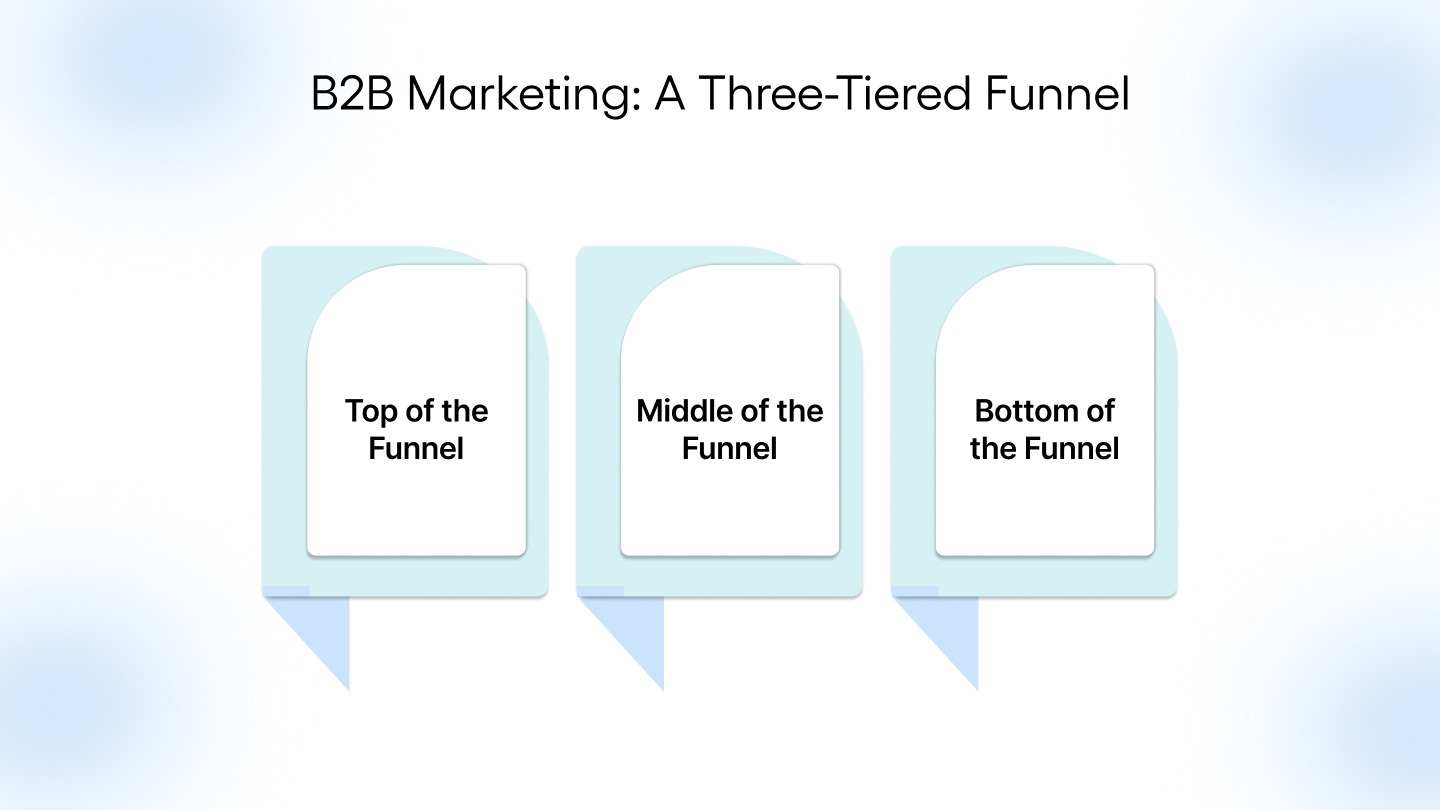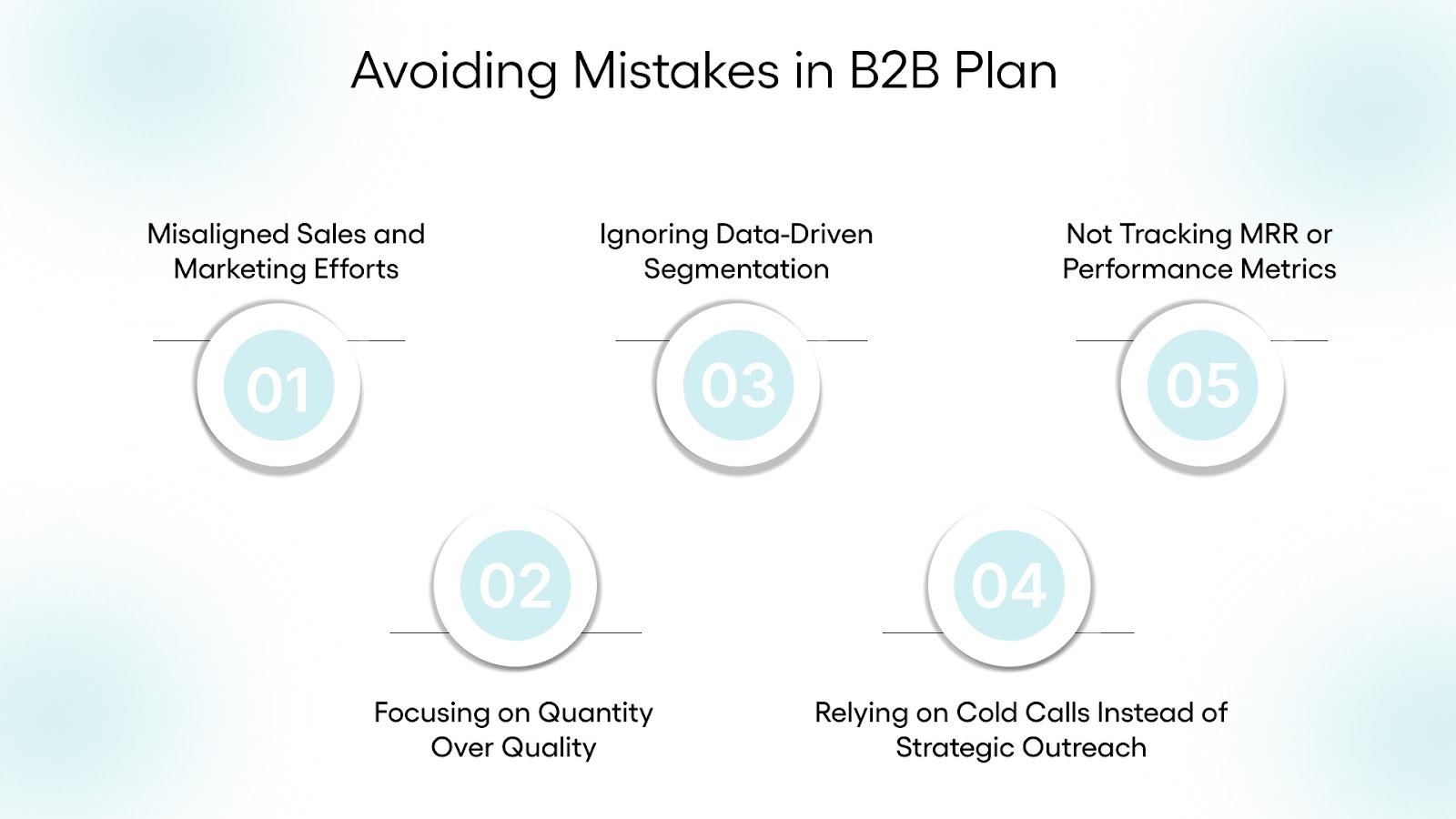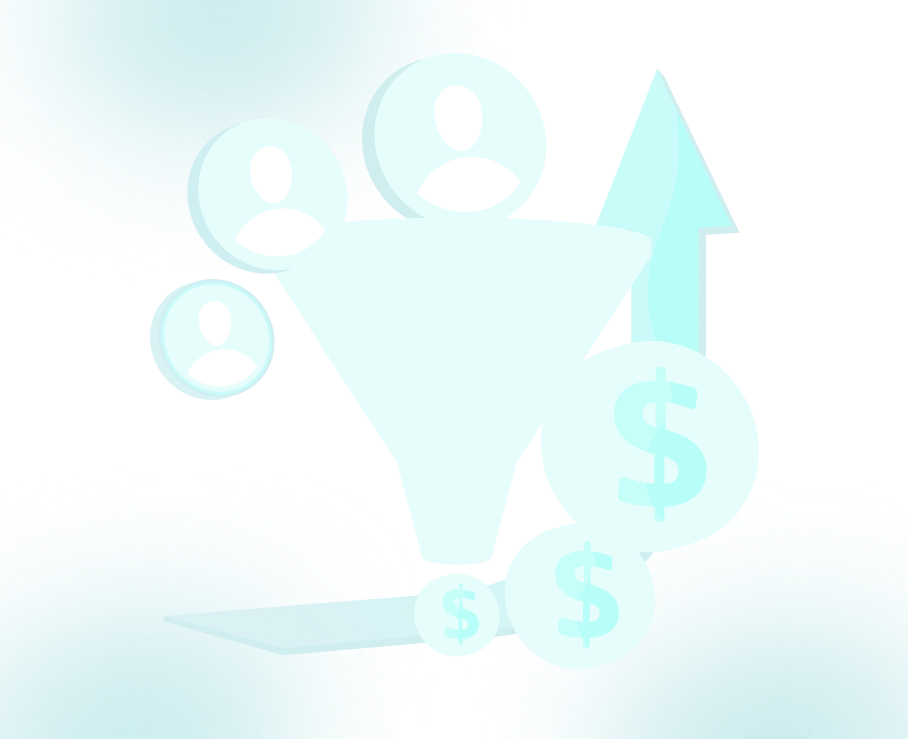
Essential Elements for Building a B2B Sales Marketing Strategy

Building predictable revenue in the Business-to-Business (B2B) sales environment requires more than just strong products or persuasive sales teams. It demands a clear, data-driven roadmap. A well-structured B2B sales marketing plan ensures every marketing initiative directly supports your sales objectives, keeping both marketing and sales teams aligned toward measurable business growth.
For many Small and Medium Enterprises (SMEs), challenges like low-quality leads, unqualified prospects, and disconnected campaigns can stall sales momentum. Without a unified strategy, marketing efforts may fail to convert into meaningful sales conversations, impacting overall Monthly Recurring Revenue (MRR).
A 2025 study found that 76% of B2B businesses have developed a formal marketing plan, highlighting the importance of strategic alignment between marketing and sales teams in driving predictable revenue growth.
To effectively use this growth potential, it’s essential to understand what a B2B sales marketing plan entails and how it bridges marketing and sales efforts to generate qualified leads and drive revenue.
Quick Overview
- A B2B sales marketing plan aligns marketing and sales teams to generate high-quality leads, nurture prospects, and drive predictable revenue growth.
- B2B marketing uses a funnel with awareness (top), engagement/nurturing (middle), and conversion/sales enablement (bottom) to guide prospects through longer, multi-stakeholder buyer journeys.
- B2B focuses on education, relationships, and multiple decision-makers, while B2C prioritizes quick, individual purchase decisions and impulse-driven actions.
- Effective plans include a clear ICP definition, aligned goals, lead generation, appointment setting, demand generation, ABM, analytics, and tactics like niche strategy, content marketing, automation, and testing.
- Common pitfalls include misaligned teams, low-quality leads, ignoring segmentation, and poor tracking. Partnering with experts (e.g., TLM) ensures a scalable, data-driven, results-oriented B2B plan.
What Is a B2B Sales Marketing Plan?
A B2B sales marketing plan is a coordinated strategy that aligns your marketing and sales teams to achieve shared business goals. Unlike general marketing plans that focus solely on brand awareness, a sales marketing plan is designed to attract, nurture, and convert qualified business leads into paying customers.
At its core, a strong B2B sales and marketing plan combines targeted outreach, audience segmentation, and performance-driven campaigns. It ensures marketing generates leads that are Sales-Qualified Leads (SQLs) and ready for conversion.

A comprehensive B2B sales marketing plan typically includes:
- Defining your Ideal Customer Profile (ICP): Identify the companies and decision-makers most likely to benefit from your solution.
- Developing outreach channels: Use email marketing, Account-Based Marketing (ABM), demand generation, and other strategies to reach the right audience.
- Setting shared KPIs: Track conversion rates, MRR, or appointment-to-sale ratios to measure success.
- Building feedback loops: Ensure continuous communication between marketing and sales to improve lead quality and campaign effectiveness.
With a clear understanding of what a B2B sales marketing plan entails, the next step is to explore how marketing activities fit into a structured three-tiered B2B marketing funnel that guides prospects from awareness to conversion.
B2B Marketing: A Three-Tiered Funnel
B2B marketing can be visualized as a three-tiered funnel, with each tier representing a stage in the buyer’s journey. Understanding how to apply the right strategies at each stage ensures meaningful engagement and drives consistent revenue growth.

1. Top of the Funnel: Awareness and Visibility
At this stage, your audience is largely unaware of your products or services. The goal is to increase visibility and attract relevant leads without pushing for immediate sales.
Top-of-funnel B2B marketing techniques include:
- Attending, speaking, or networking at industry conferences
- Publishing thought leadership articles in widely read industry publications
- Sharing informative social content to introduce your brand to new prospects
The key objective here is to showcase expertise and create a pathway for prospects to engage further.
2. Middle of the Funnel: Engagement and Nurturing
The middle tier focuses on building trust and nurturing relationships over time. Many buyers are not ready to purchase immediately, so rushing them can reduce conversion rates.
Middle-of-funnel strategies include:
- Hosting webinars or live events where prospects can learn and ask questions
- Sending educational email campaigns with newsletters, blog posts, guides, or white papers
- Segmenting audiences by industry or interest to provide highly relevant content
This stage ensures leads are well-informed and engaged, preparing them for the next stage of the funnel.
3. Bottom of the Funnel: Conversion and Sales
At the bottom tier, buyers are ready to make a decision. Marketing’s role is to support the sales team with the tools and resources needed to close deals effectively.
Bottom-of-funnel strategies include:
- Providing sales teams with pitch decks, case studies, and qualification packages
- Preparing personalized proposals addressing specific buyer needs
- Offering live demos, consultations, or direct meetings for qualified prospects
When executed correctly, this tier directly drives revenue growth by converting qualified leads into customers.
Understanding the B2B funnel makes it clear why these strategies differ significantly from B2C marketing approaches, which is the focus of the next section.
Also Read: What Your Sales Team Should Do with Marketing Qualified Leads
How B2B Marketing Techniques Differ from B2C Strategies
While both B2B and B2C marketing aim to drive engagement and sales, their approaches differ due to the nature of the buyer and the complexity of the purchase process. B2B marketing focuses on longer, multi-stakeholder journeys, while B2C often targets faster, individual purchase decisions.
These differences highlight why B2B marketing strategies need to be educational, strategic, and relationship-driven, whereas B2C strategies often prioritize speed and impulse.
With a clear understanding of how B2B marketing differs from B2C, the next step is to identify the essential elements of a strong B2B sales marketing plan that align sales and marketing for predictable growth.
7 Essential Elements of a Strong B2B Sales Marketing Plan
Understanding these seven essential elements will help you create a structured, results-driven B2B sales marketing plan that aligns your sales and marketing efforts while driving consistent MRR growth. Each element builds on the previous, creating a cohesive roadmap from target audience definition to performance tracking.

1. Clear Target Audience Definition
A successful B2B sales marketing plan starts with a precise understanding of your ideal customers. Defining your ICP ensures marketing and sales teams focus on prospects most likely to convert, saving time and boosting MRR.
Key attributes to define your ICP:
- Industry or sector
- Company size and revenue
- Geographic location
- Key decision-maker roles
A well-defined ICP guides personalized email campaigns, targeted ABM strategies, and demand generation efforts, ensuring every outreach delivers SQLs ready for engagement.
2. Aligned Sales and Marketing Goals
Alignment between sales and marketing teams eliminates wasted resources and friction. Establishing shared metrics ensures both teams work toward the same objectives. Common shared goals include:
- Number of SQLs generated
- Appointments scheduled per month
- Conversion rates from lead to sale
- Contribution to MRR
Shared goals create a unified approach where marketing knows which leads to prioritize, and sales understands each prospect’s readiness.
3. Lead Generation Framework
Generating leads is not just about quantity. It’s about quality. A structured framework combines inbound and outbound tactics to deliver high-value, sales-ready prospects.
- Outbound: Targeted emails, account-based outreach, personalized messaging.
- Inbound: Content marketing, webinars, gated resources, attracting prospects actively seeking solutions.
Email marketing remains one of the most reliable B2B channels, nurturing leads effectively without overreliance on cold calls.
4. Appointment Setting and Nurturing Processes
Even high-quality leads require strategic follow-up. Appointment setting and nurturing processes ensure prospects progress toward meaningful conversations. Effective strategies include:
- Personalized messaging and timely emails
- Targeted follow-ups based on lead engagement
- Multi-touch campaigns guiding leads through the funnel
Nurturing improves conversion rates while optimizing the sales team’s time and effort.
5. Demand Generation and Brand Awareness
Demand generation focuses on creating and sustaining interest in your products or services until prospects are ready to buy. This involves:
- Multi-channel campaigns: email, social media, webinars
- Consistent content outreach
- Maintaining top-of-mind visibility
Strong brand presence builds trust, positions your company as a credible solution provider, and fuels a steady pipeline of engaged leads.
6. Account-Based Marketing (ABM) for High-Value Targets
Not all leads are equal. ABM focuses on high-value accounts, delivering personalized campaigns to decision-makers who matter most. Benefits of ABM include:
- Higher engagement rates
- Shortened sales cycles
- Increased MRR through tailored communications
ABM aligns marketing and sales to deliver targeted, impactful outreach to prospects with the highest potential.
7. Real-Time Analytics and Performance Tracking
A plan is only as effective as the insights it generates. Real-time analytics and reporting track:
- SQL conversion rates
- Appointments booked
- MRR growth
Dashboards provide immediate visibility into what’s working and what needs adjustment, enabling data-driven decisions that continuously optimize campaigns and drive predictable revenue.
With these essential elements in place, businesses can structure a comprehensive B2B sales marketing plan, but strategy alone isn’t enough; executing with proven marketing techniques is key to achieving measurable results.
Also Read: Future of B2B Sales: Trends and Strategies for 2025
Top 9 B2B Marketing Strategies
A successful B2B sales marketing plan combines research, technology, and strategic outreach to attract, nurture, and convert high-value leads. Implementing these strategies ensures alignment across marketing and sales, creating a predictable pipeline and driving MRR growth.

Alt text:Top 9 B2B Marketing Strategies
1. Research
Research forms the foundation of any modern marketing strategy. Conducting market, audience, and brand research helps you:
- Understand client needs and behaviors
- Identify areas of success and opportunities for improvement
- Measure results against clear baselines
Example: Firms that systematically research prospects and clients grow up to 10x faster and are twice as profitable as peers who skip research.
2. Niche-Driven Strategy
Specialization strengthens your brand and marketing efforts. Focus on a specific industry niche where you can establish expertise. Benefits include:
- Clear differentiation from competitors
- Easier messaging and positioning
- Enhanced credibility as an industry leader
3. High-Performance Website
Your website is more than a digital brochure. It’s the hub of your online presence. A high-performing site should:
- Clearly communicate your expertise and offerings
- Include educational content that guides prospects through the funnel
- Feature responsive design for mobile and desktop users
- Reinforce credibility through design and messaging
4. Search Engine Optimization (SEO)
SEO ensures your target audience finds your website organically. Key components include:
- On-site SEO: Targeted keywords to signal your expertise
- Off-site SEO: Backlinks from reputable sources to boost authority
Higher SEO maturity correlates with more digital leads and greater profitability due to lower acquisition costs.
5. Advertising
Targeted advertising amplifies reach and drives conversions. Effective channels include:
- Industry publications and websites
- Social media ads, particularly LinkedIn
- Search engine marketing (Google Ads, Bing)
- Retargeting campaigns to re-engage visitors
Advertising supports content downloads, lead generation, and brand visibility.
6. Referral Marketing
Referrals remain a powerful B2B strategy. Building a reputation for niche expertise attracts new business. Strategies include:
- Thought leadership content
- Case studies and success stories
- Networking within industry-specific communities
7. Marketing Automation, CRM, and Lead Nurturing
Technology streamlines repetitive tasks and improves lead management:
- Marketing Automation: Centralizes campaigns, tracks engagement, and nurtures leads
- CRM: Organizes client and prospect data for team-wide access
- Lead Nurturing: Analytics-driven email campaigns and drip sequences educate and engage prospects over time
8. Testing and Optimization
Continuous testing ensures marketing effectiveness. Key approaches:
- A/B testing: Compare emails, landing pages, or offers to maximize conversions
- Rendering tests: Ensure emails display correctly on all devices
- Ongoing adjustments: Refine campaigns based on real data
9. Analytics and Reporting
Analytics transforms marketing from an art into a science:
- Track metrics across SEO, social media, email, and website performance
- Use tools like Google Analytics, Moz, SEMrush, Hootsuite, or Zoho Social
- Make data-driven decisions to optimize campaigns and improve MRR
With these marketing strategies implemented effectively, your B2B sales marketing plan moves from theory to action, generating leads, nurturing prospects, and enabling measurable sales growth.
Common Mistakes to Avoid When Creating a B2B Sales and Marketing Plan
Even the best strategies can fail if certain pitfalls are overlooked. Recognizing and addressing these mistakes early ensures your B2B sales marketing plan drives consistent MRR growth.

- Misaligned Sales and Marketing Efforts: When teams work in silos, marketing may generate leads that don’t meet sales criteria, wasting time and resources.
- Focusing on Quantity Over Quality: Chasing large volumes of leads without considering their readiness to convert dilutes efforts and slows pipeline growth.
- Ignoring Data-Driven Segmentation: Failing to segment audiences by industry, role, or company size reduces engagement and the effectiveness of personalized messaging.
- Relying on Cold Calls Instead of Strategic Outreach: Traditional cold calling is often inefficient. Email marketing, ABM campaigns, and targeted content generate SQLs with higher conversion potential.
- Not Tracking MRR or Performance Metrics: Without measuring SQLs, appointments booked, and revenue contribution, it’s impossible to know whether the plan is driving results or wasting resources.
By avoiding these common mistakes, businesses can focus on proven strategies and tools, like those offered by TLM, to create a scalable, results-driven B2B sales marketing plan.
Also Read: Effective B2B Sales Strategies and Solutions Guide
How TLM Helps You Build a Scalable B2B Sales Marketing Plan
Creating a B2B sales marketing plan that consistently drives results requires expertise, data-driven strategies, and proven tools. TLM (The Lead Market) specializes in aligning marketing and sales efforts to generate high-quality leads, streamline processes, and grow MRR efficiently.
Key TLM Services Include:
- SQL Generation: Targeted campaigns deliver leads ready for engagement, ensuring your sales team spends time on prospects with high conversion potential.
- Appointment Scheduling: Convert SQLs into confirmed meetings, saving sales teams time and accelerating revenue growth.
- Demand Generation: Channel to outreach and nurture prospects until they are ready to convert, keeping your brand top of mind.
- Targeted Campaigning & ABM: Personalized outreach for high-value accounts increases engagement, shortens sales cycles, and improves conversion rates.
- Real-Time Analytics & Reporting: Dashboards monitor campaigns, optimize messaging, and track MRR growth, ensuring data-driven decisions.
With over nine years of experience serving clients across the USA, Canada, and Australia, especially MSPs, tech firms, and staffing companies, TLM ensures every B2B marketing strategy is scalable, efficient, and results-driven. Contact our team today to get started!
Conclusion
A well-executed B2B sales marketing plan aligns sales and marketing teams, targets the right prospects, and nurtures leads through every stage of the pipeline. By integrating lead generation, appointment scheduling, demand generation, and account-based marketing, businesses can focus on high-value prospects, reduce wasted effort, and grow MRR consistently.
With TLM (The Lead Market), your B2B strategy becomes scalable and results-driven. Our services help you generate SQLs, schedule appointments efficiently, and convert prospects into revenue-driving customers.
Ready to strengthen your B2B sales and marketing plan? Schedule a Meeting with TLM today to see how our SQL and appointment scheduling services can streamline your pipeline and boost MRR.
FAQs
1. What is a B2B marketing plan?
A B2B marketing plan is a strategic roadmap that outlines how a business will promote its products or services to other businesses. It defines your target audience, marketing goals, key messaging, and the tactics used to generate leads, nurture prospects, and drive MRR growth. A solid plan integrates strategies such as email marketing, demand generation, account-based marketing (ABM), and lead nurturing, ensuring that sales and marketing efforts are aligned to convert high-quality prospects into customers.
2. What is CRM in marketing?
CRM (Customer Relationship Management) is a system or software that helps businesses manage interactions with current and potential customers. In marketing, a CRM stores contact information, tracks engagement, monitors lead progress, and helps coordinate campaigns across teams. By centralizing data, marketers can segment audiences, personalize communications, and improve the efficiency of B2B lead generation and nurturing efforts, ultimately supporting higher conversion rates and MRR.
3. What is a KPI in marketing?
A KPI (Key Performance Indicator) in marketing is a measurable value that indicates how effectively a campaign or strategy is achieving its objectives. Common KPIs in B2B marketing include:
- Number of sales-qualified leads (SQLs) generated
- Conversion rates from leads to meetings
- Email open and click-through rates
- Website traffic and engagement metrics
Tracking KPIs allows businesses to optimize campaigns, allocate resources efficiently, and make data-driven decisions that improve overall ROI and pipeline performance.
4. What is included in a B2B sales marketing plan?
A comprehensive B2B sales marketing plan includes audience targeting, lead generation, appointment setting, demand generation, ABM strategies, and measurable KPIs like SQLs and MRR growth.
5. Why is email marketing effective in a B2B sales marketing plan?
Email marketing delivers personalized, targeted messaging directly to decision-makers, increasing engagement, reducing reliance on cold calls, and improving conversion rates.
6. How can TLM improve my company’s B2B sales process?
TLM helps businesses generate high-quality, sales-qualified leads (SQLs), convert them into appointments, and nurture prospects through multi-channel campaigns. This alignment between marketing and sales drives predictable MRR growth.
7. How do I get started with TLM?
You can schedule a meeting with TLM to discuss your B2B sales and marketing plan and explore how our services, from SQL generation to appointment scheduling and ABM, can help your business grow MRR.





